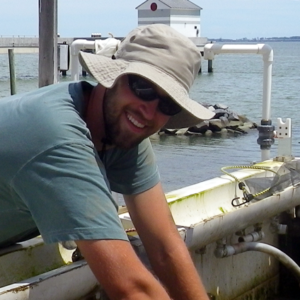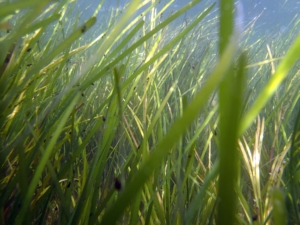
Underwater grasses photographed by Lefcheck
A landmark paper authored by a power-house of Bay scientists has rocked the Chesapeake Bay for the past two months. The paper looks at the long-term effects of nutrient reductions in the Chesapeake Bay watershed on underwater grasses, or submerged aquatic vegetation (SAV). It was published in the prestigious Proceedings of the National Academy of Sciences (PNAS) and written by Jonathan Lefcheck, Robert “JJ” Orth, William Dennison, and a slew of other SAV experts, including researchers from the Bigelow Lab for Ocean Science, the Virginia Institute of Marine Science (VIMS), University of Maryland Center for Environmental Science (UMCES), USGS, EPA, and others.

Jonathan Lefcheck
Using 30 years of biogeochemical data, watershed modeling, and aerial surveys, the researchers were able to make the crucial link between nutrient pollution and SAV coverage. The study found that SAV “has regained 17,000 ha to achieve its highest cover in almost half a century,” while nitrogen concentrations have gone down by 23% in the Bay since 1984.
The mechanism of the findings stem from understanding how nutrients harm SAV. Nutrient pollution from fertilizer and manure applications in agriculture and urban development cause spikes in nitrogen and phosphorus levels, which stifle SAV in two major ways. The addition of phosphorous “promotes phytoplankton blooms,” restricting light to the SAV. Nitrogen stimulates algae that grow on the blades of the grasses and even accumulates sulfides that are detrimental to the plants. The study points to management of these pollutants by watershed groups like the Chesapeake Bay Program as a major contributor to the success of SAV in the past few years and overall.
One of the most important caveats of the paper is that it looks at long term trends over the Bay. So even though SAV does not always cover more ground than the year before, the researchers note that the overall trend is improving. The team is confident that the SAV trend is linked to nutrient pollution because they evaluated many factors, including habitable area, salinity and others, and used several different analysis tools to make the link. They blame year-to-year variability on disturbance events, like storms, and issues with the data collection method. For example, because the coverage data was collected through aerial monitoring, it was difficult to account for sparse, patchy SAV in low years.

More grasses by Lefcheck
The researchers had a surprise discovery that “species richness was the only predictor… to have a positive effect on SAV cover.” Lefcheck, the lead author of the paper, theorizes that biodiversity could help grass beds recover more quickly from disturbance events. For example, in a bed with only one species of grass, a disturbance event or change in environmental conditions could completely wipe out the bed if that species is intolerant to those conditions. If there are multiple species there, however, a more tolerant species may survive the event and help trap seeds floating by, making for a quicker recovery the following year. Although more research is needed to determine which species are the most tolerant, Lefcheck recommends that planting many species together will have the most success.
Moving forward, climate change will continue to pose a mounting threat to SAV success. Robert Orth, another author on the study and a longtime Bay scientist and SAV researcher, predicts that “some species that are tolerant of warmer temperatures will do better.” He added that continuing to improve water quality will give the SAV a fighting chance, explaining that, “improving water quality could [minimize] negative effects of temperature.”
In future studies, researchers hope to better gauge how sediments affect SAV populations. In this study, the team found that sediments “did not emerge as a strong predictor of cover,” adding that perhaps sediments “provide little explanatory power at large scales,” and that “phytoplankton play a larger role in light attenuation.” The researchers also point to holes in the data, noting that local sediment concentrations “were available for only 17 of the 30 study years.”
The researchers look forward to many more years of data, exclaiming that “we believe the general trajectory will be up.” Lefcheck added, “this is not the end… five, ten, twenty years of data will help isolate the factors that will reinforce the conclusions of this paper.”
